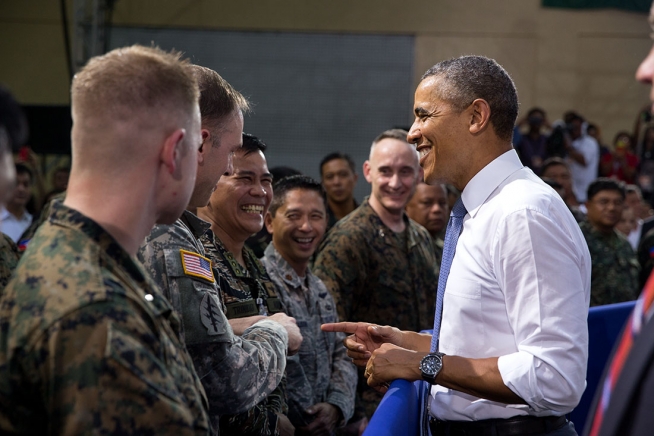In 1992 the United States left its naval facility at Subic Bay and its air force base at Clark Air Base in the Philippines. An active volcano, Mt Pinatubo, and a restless Philippines Senate opposed to the US military presence, had between them brought an end to US access to the facilities. But last week the two countries signed a ten year Enhanced Defense Cooperation Agreement.
The agreement will allow US armed forces regular access to Philippine military bases. It’s a framework agreement, with the details, such as how many US troops will rotate through the Philippines and when, to be negotiated and announced later.
The EDCA does not authorise the establishment of permanent bases, which is prohibited by the Philippine constitution, but permits US military access to agreed locations. This will allow the US to pre-position supplies, equipment and materiel (excluding nuclear weapons) in the Philippines.
President Obama said the deal would see more US troops rotate through the country for joint military training exercises and give US forces greater access to Filipino facilities, airfields and ports. But there’d be no return of American bases.
President Obama stated that the US remained committed to supporting the Philippines, referring to the two nations’ 1951 mutual defence treaty. But he made no mention of the hotspots in the South China Sea when speaking about the mutual defence pact, instead calling on China not to use intimidation to assert its claims.
The Philippines signed the EDCA at least in part to increase its leverage in dealing with China. With EDCA, there’ll be more joint military exercises which Manila hopes will help keep China at bay. The Philippines needs EDCA to level-up its military capabilities to better protect its ocean territory: maritime security and maritime domain awareness are two of the essential objectives of EDCA.
Through EDCA the Philippines expects greater access to Excess Defence Articles, International Military Education and Training, and the US Military Assistance Fund. It expects an annual assistance of $50 million from the US(compared to its current annual $25 million).
In Australia, we sometimes forget that the Philippines occupies an important geostrategic location between the Americas, Oceania and Asia; it serves as a bridge between Southeast and Northeast Asia. Important shipping routes between Australia and China pass through the Philippines archipelago, including through the Sulu Sea, the site of considerable illegal activity.
We should be supporting the Philippines strengthening its capacity to protect its maritime interests, although without engaging in activities that could appear to support Manila’s sovereignty claims in the South China Sea. At times, that’s likely to prove a delicate balancing act for both the US and Australia: it’ll sometimes be hard to separate our common interest in freedom of navigation from the Philippines’ interest in the islands in the South China Sea. Already China thinks that whatever the Philippines is doing is simply part of US strategy.
Fortunately Australian and Philippine interests converge more in the Sulu and Celebes Seas. That provides us greater leeway in terms of the kind and levels of assistance we can give to the Philippines to improve their maritime domain awareness and maritime security capabilities.
The Philippines’ planned defence transformation program is intended primarily to meet external maritime security threats, with its navy and coast guard getting new ships and maritime surveillance aircraft. Last year it was announced that ten vessels from Japan are to be sent to Manila as part of Prime Minister Abe’s promise to beef up the capability of the Philippine Coast Guard. The cutters are being provided as part of Japan’s official development assistance program.
The Philippines’ National Coast Watch System (NCWS) is also being developed to enhance interagency coordination and maritime security across the Philippines archipelago. It builds on the Coast Watch South System established by the Philippines with the assistance of Australia and the US in the tri-border area in the Sulu and Celebes Seas between Indonesia, Malaysia and the Philippines.
We should be providing support for the NCWS, which will be a multi-agency arrangement. The US has already offered to help the Philippines establish a coast watch centre to enhance its maritime border security and promote enhanced maritime information-sharing between the Philippines, Japan and Australia.
Australia’s 2012 Status of Visiting Forces Agreement with the Philippines also opens up the possibility of more training opportunities and more advanced exercises, as well as assisting the Philippines armed forces with training in procurement processes. Both countries should now work to enhance security cooperation, especially in the maritime domain, in the years to come.
Anthony Bergin is deputy director of ASPI. Image courtesy of the White House.


